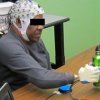Brain-computer interfaces (BCIs) that are able to discern narrowly defined activities, such as different hand grasps, have required implanting electrodes into the brain that read signals from small groups of neuronal cells. This has severely limited the capabilities of BCIs and has kept them pretty much constrained only to small experiments. Being able to overcome this through advanced interpretation of electroencephalography (EEG) signals that are captured non-invasively, researchers may one day develop thought-controlled prosthetic devices that don’t require a hole in the skull.
A major step towards that goal has just been reported in the journal Frontiers in Neuroscience by researchers at the University of Houston. They were able to use a traditional EEG to identify “hand joint angular velocities as well as synergistic trajectories” within the brain signals of human volunteers as they were reaching and grasping for objects.
This information was then used to create a template to be able to identify hand grasps in an amputee who was able to control a prosthetic hand using nothing but the power of thought.
source:University of Houston
Mind Controlled Prosthetic Hand Works Without Brain Implants

